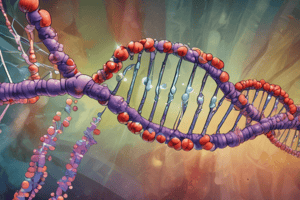Podcast
Questions and Answers
What are the four types of DNA repair mechanisms?
What are the four types of DNA repair mechanisms?
Mismatch repair, Base-excision repair, Nucleotide-excision repair, Direct repair
How is the DNA molecule repaired when damaged?
How is the DNA molecule repaired when damaged?
DNA damage in one strand can be removed and replaced using the undamaged complementary strand as a template.
What are the most common forms of DNA damage mentioned in the lecture?
What are the most common forms of DNA damage mentioned in the lecture?
- A missing, altered, or incorrect base (correct)
- Covalent cross-linking of strands (correct)
- UV-induced pyrimidine dimers (correct)
- Bulges due to deletions or insertions (correct)
- Strand breaks at phosphodiester bonds or within deoxyribose rings (correct)
The repair system of the cell can distinguish between the old (template) strand and the newly synthesized strands.
The repair system of the cell can distinguish between the old (template) strand and the newly synthesized strands.
Match the following DNA repair systems with their descriptions:
Match the following DNA repair systems with their descriptions:
Flashcards are hidden until you start studying
Study Notes
Introduction to DNA Repair Mechanisms
- Biological macromolecules like DNA, RNA, and proteins are susceptible to chemical alterations due to environmental damage or synthesis errors.
- DNA's integrity is vital to cell survival and reproduction, so it has high-fidelity replication systems and repair systems to correct DNA damage.
Types of DNA Damage
- Common forms of DNA damage include:
- Missing, altered, or incorrect bases
- Bulges due to deletions or insertions
- UV-induced pyrimidine dimers
- Strand breaks at phosphodiester bonds or within deoxyribose rings
- Covalent cross-linking of strands
Types of DNA Repair Systems
- There are four main types of DNA repair systems:
- Mismatch repair
- Base-excision repair
- Nucleotide-excision repair
- Direct repair
Mismatch Repair (MMR)
- MMR corrects mismatches left after replication by distinguishing between the old (template) strand and the newly synthesized strands.
- The cell tags the template DNA with methyl groups to distinguish it from newly synthesized strands.
- The MMR system includes at least 12 protein components that function in strand discrimination or repair.
- The process involves four phases: recognition of a mismatch, recruitment of repair enzymes, excision of the incorrect sequence, and resynthesis using the parent strand as a template.
Base-Excision Repair (BER)
- BER is a major pathway for repairing damages caused by oxidation, alkylation, hydrolysis, depurination, and deamination.
- Enzymes called DNA glycosylases recognize and remove deaminated and modified bases by cleaving the N-glycosyl bond, creating an AP site.
- Another enzyme then repairs the AP site by removing the deoxyribose 5'-phosphate and replacing it with a new nucleotide.
Nucleotide-Excision Repair (NER)
- NER repairs DNA lesions that cause large distortions in the helical structure, such as cyclobutane pyrimidine dimers, 6-4 photoproducts, and base adducts.
- The process involves a multisubunit enzyme (excinuclease) that hydrolyzes two phosphodiester bonds on either side of the lesion, followed by the release of the excised oligonucleotides, gap filling by DNA polymerase, and nick sealing by DNA ligase.
Direct Repair
- Direct repair corrects damage without removing a base or nucleotide.
- Examples include:
- Repair of pyrimidine dimers with photolyase: energy derived from absorbed light is used to reverse the photoreaction that caused the lesion.
- Repair of nucleotides with alkylation damage, such as 𝑶6 -methylguanine and 1-methyladenine.
Studying That Suits You
Use AI to generate personalized quizzes and flashcards to suit your learning preferences.




